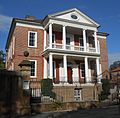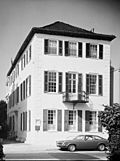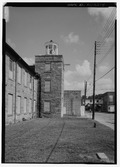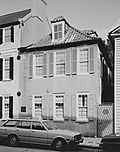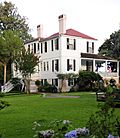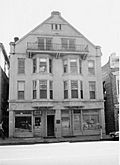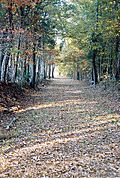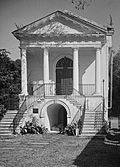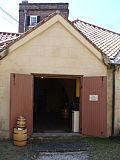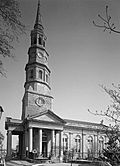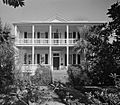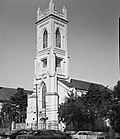List of National Historic Landmarks in South Carolina facts for kids
This is a List of National Historic Landmarks in South Carolina, United States. The United States' National Historic Landmark (NHL) program is operated under the auspices of the National Park Service, and recognizes buildings, sites, structures, districts, and objects according to a list of criteria of national significance. There are 76 NHLs in South Carolina and 3 additional National Park Service-administered areas of primarily historic importance.
Architects whose work is recognized by two or more separate NHLs in the state are:
- Robert Mills (8 sites),
- Edward Brickell White (4 sites),
- Gabriel Manigault (3 sites), and
- William Wallace Anderson (2 sites).
These tallies do not include any buildings that are contributing properties within historic districts unless they are also individually designated as NHLs.
There are five places listed for their association with artists and writers.
There are four World War II-era museum ships; all are located at Patriot's Point in Charleston Harbor.
Contents
Current NHLs in South Carolina
The 76 NHLs in South Carolina are distributed across 16 of the 46 counties in the state; 42 of the 76 are located in Charleston County.
| Landmark name | Image | Date designated | Location | County | Description | |
|---|---|---|---|---|---|---|
| 1 | William Aiken House and Associated Railroad Structures |
(#66000698) |
Charleston 32°47′21″N 79°56′15″W / 32.789167°N 79.9375°W |
Charleston | Structures of South Carolina Canal and Railroad Company, the longest operating railroad in the world in 1833, and home of founder William Aiken | |
| 2 | Atalaya and Brookgreen Gardens |
(#84002045) |
Murrells Inlet 33°30′50″N 79°05′07″W / 33.513889°N 79.085278°W |
Georgetown | Landmark combining Atalaya and portions of Brookgreen Gardens associated with artist Anna Hyatt Huntington | |
| 3 | Beaufort Historic District |
(#69000159) |
Beaufort 32°26′08″N 80°40′04″W / 32.435556°N 80.667778°W |
Beaufort | ||
| 4 | Bethesda Presbyterian Church |
(#85003258) |
Camden 34°14′48″N 80°36′19″W / 34.246589°N 80.605213°W |
Kershaw | Church designed by Robert Mills | |
| 5 | William Blacklock House |
(#73001681) |
Charleston 32°46′59″N 79°56′22″W / 32.782927°N 79.939353°W |
Charleston | Adamesque house, possibly designed by Gabriel Manigault | |
| 6 | Borough House |
(#72001224) |
Stateburg 33°57′14″N 80°32′16″W / 33.953889°N 80.537778°W |
Sumter | "The oldest and largest collection of 'high style' pise de terre (rammed earth) buildings in the United States". Across the road from Church of the Holy Cross | |
| 7 | Miles Brewton House |
(#66000699) |
Charleston 32°46′20″N 79°55′56″W / 32.772131°N 79.932201°W |
Charleston | Fine examples of a "double house" (having four main rooms per floor) in Charleston | |
| 8 | Robert Brewton House |
(#66000700) |
Charleston 32°46′28″N 79°55′45″W / 32.774388°N 79.929041°W |
Charleston | Charleston's oldest dated "single" house (one room wide, with the narrow end toward the street, and entry centered in long side) | |
| 9 | Brick House Ruins |
(#70000580) |
Edisto Island 32°35′59″N 80°19′32″W / 32.599774°N 80.325420°W |
Charleston | Ruins of a plantation house that burned in 1929 | |
| 10 | Burt-Stark Mansion |
(#70000559) |
Abbeville 34°10′49″N 82°22′55″W / 34.180317°N 82.382023°W |
Abbeville | Where the American Civil War ended. | |
| 11 | Camden Battlefield |
(#66000707) |
Camden 34°20′47″N 80°36′27″W / 34.346389°N 80.6075°W |
Kershaw | Site of Battle of Camden, British victory in 1780 | |
| 12 | Chapelle Administration Building |
(#76001710) |
Columbia 34°00′37″N 81°01′15″W / 34.010263°N 81.020966°W |
Richland | Allen University building designed by John A. Lankford, "dean of black architecture" | |
| 13 | Charlesfort-Santa Elena Site |
(#74001822) |
Parris Island 32°18′23″N 80°40′32″W / 32.306389°N 80.675556°W |
Beaufort | Archeological site of French fort built in 1562 and Spanish forts built in 1566 and after. | |
| 14 | Charleston Historic District |
(#78002497) |
Charleston 32°47′08″N 79°56′13″W / 32.785556°N 79.936944°W |
Charleston | Historic district including 81 contributing properties and 700 others. | |
| 15 | Church of the Holy Cross |
(#73001732) |
Stateburg 33°57′39″N 80°31′55″W / 33.960744°N 80.531944°W |
Sumter | Gothic Revival Church constructed of rammed earth in 1852. Across the road from Borough House | |
| 16 | USS Clamagore |
(#89001229) |
Mount Pleasant 32°47′16″N 79°54′28″W / 32.787883°N 79.907744°W |
Charleston | A submarine that was in training when World War II ended | |
| 17 | Coker Experimental Farms |
(#66000706) |
Hartsville 34°21′47″N 80°03′35″W / 34.363056°N 80.059722°W |
Darlington | Site of crop-improvement experiments that "played a great role in the agricultural revolution of the South" | |
| 18 | College of Charleston |
(#71000748) |
Charleston 32°47′03″N 79°56′17″W / 32.784167°N 79.938056°W |
Charleston | Historic and attractive campus center; Randolph Hall, Towell Library, and Gate Lodge completed by 1856, designed by William Strickland, Edward Brickell White, and George E. Walker | |
| 19 | Drayton Hall |
(#66000701) |
Charleston 32°52′15″N 80°04′35″W / 32.8709°N 80.0763°W |
Charleston | Plantation house built in 1742 of Palladian architectural style | |
| 20 | Exchange and Provost |
(#69000160) |
Charleston 32°46′37″N 79°55′37″W / 32.776842°N 79.927009°W |
Charleston | Variously a customhouse, mercantile exchange, military prison and barracks, post office, and meeting place of the 1790 State Legislature | |
| 21 | Farmers' and Exchange Bank |
(#73001685) |
Charleston 32°46′39″N 79°55′37″W / 32.777435°N 79.926964°W |
Charleston | A unique Moorish-style bank building built in 1854 | |
| 22 | Fig Island |
(#70000585) |
Charleston 32°34′13″N 80°12′55″W / 32.5703°N 80.2153°W |
Charleston | Archaeological site that is "one of the most complex shell-ring sites" in the United States | |
| 23 | Fireproof Building |
(#69000161) |
Charleston 32°46′37″N 79°55′52″W / 32.776923°N 79.931052°W |
Charleston | Designed by Robert Mills to be the most fireproof building in America; now the South Carolina Historical Society building. | |
| 24 | First Baptist Church |
(#71000800) |
Columbia 34°00′21″N 81°02′00″W / 34.005864°N 81.033450°W |
Richland | Where the American Civil War started, with the secession of South Carolina from the Union. | |
| 25 | Fort Hill (John C. Calhoun House) |
(#66000708) |
Clemson 34°40′34″N 82°50′21″W / 34.675976°N 82.839208°W |
Pickens | Home of John C. Calhoun, now within Clemson University campus. | |
| 26 | William Gibbes House |
(#70000575) |
Charleston 32°46′15″N 79°56′04″W / 32.770701°N 79.934493°W |
Charleston | Adamesque style home with a beautiful ballroom, and exceptional wrought iron work and marble steps in front | |
| 27 | Graniteville Historic District |
(#78002491) |
Graniteville 33°34′01″N 81°48′30″W / 33.566893°N 81.808377°W |
Aiken | Textile mill town with Gothic revival church and carpenter gothic homes | |
| 28 | Hampton Plantation |
(#70000582) |
McClellanville 33°11′54″N 79°26′16″W / 33.198333°N 79.437778°W |
Charleston | "South Carolina's finest example of a large two-and-a-half frame Georgian plantation house" | |
| 29 | Dubose Heyward House |
(#71000749) |
Charleston 32°46′29″N 79°55′45″W / 32.774663°N 79.929029°W |
Charleston | Home of Dubose Heyward, author of the novel Porgy. | |
| 30 | Heyward-Washington House |
(#70000576) |
Charleston 32°46′31″N 79°55′45″W / 32.775337°N 79.929125°W |
Charleston | Residence of George Washington during his 1792 visit to Charleston | |
| 31 | Hibernian Hall |
(#73001686) |
Charleston 32°46′39″N 79°55′52″W / 32.777469°N 79.931148°W |
Charleston | ||
| 32 | Hopsewee |
(#71000782) |
Georgetown 33°12′38″N 79°23′05″W / 33.210556°N 79.384722°W |
Georgetown | Plantation mansion built in 1749; the birthplace of Thomas Lynch Jr. | |
| 33 | Huguenot Church |
(#73001687) |
Charleston 32°46′41″N 79°55′46″W / 32.778090°N 79.929312°W |
Charleston | Gothic Revival church built in 1844; designed by architect E. B. White | |
| 34 | Kahal Kadosh Beth Elohim |
(#78002499) |
Charleston 32°46′55″N 79°55′59″W / 32.781979°N 79.932948°W |
Charleston | Greek revival building from 1840; second oldest synagogue in continuous use in the United States | |
| 35 | USS Laffey |
(#83002189) |
Mount Pleasant 32°47′16″N 79°54′28″W / 32.787883°N 79.907744°W |
Charleston | A destroyer | |
| 36 | Lancaster County Courthouse |
(#71000788) |
Lancaster 34°43′17″N 80°46′17″W / 34.721264°N 80.771369°W |
Lancaster | Courthouse in continuous use since 1828; designed by Robert Mills | |
| 37 | Lancaster County Jail |
(#71000789) |
Lancaster 34°43′06″N 80°46′17″W / 34.718335°N 80.771270°W |
Lancaster | Former jail building built in 1823, virtually unaltered work of Robert Mills, reflecting innovative changes in jail design he promoted | |
| 38 | Joseph Manigault House |
(#73001688) |
Charleston 32°47′19″N 79°56′08″W / 32.788703°N 79.935558°W |
Charleston | Home designed by Gabriel Manigault for his brother | |
| 39 | Market Hall and Sheds |
(#73001689) |
Charleston 32°46′51″N 79°55′53″W / 32.780720°N 79.931515°W |
Charleston | Greek Revival meat market with two blocks of sheds where vegetables, fish, etc., were sold | |
| 40 | Marshlands |
(#73001674) |
Beaufort 32°26′01″N 80°39′57″W / 32.433520°N 80.665831°W |
Beaufort | Home of Dr. James Robert Verdier, who discovered a treatment for yellow fever | |
| 41 | Middleburg Plantation |
(#70000568) |
Huger 33°04′52″N 79°50′35″W / 33.081111°N 79.843056°W |
Berkeley | One of the earliest frame plantation houses in the state | |
| 42 | Middleton Place |
(#71000770) |
Summerville 32°53′59″N 80°08′12″W / 32.899722°N 80.136667°W |
Dorchester | Plantation mansion and ornamental gardens on the Ashley River | |
| 43 | Millford Plantation |
(#71000808) |
Pinewood 33°44′54″N 80°32′15″W / 33.7484°N 80.53745°W |
Sumter | A monumental 2-story Greek Revival mansion built in 1839 and meticulously restored in the early 1990s. | |
| 44 | Mills Building, South Carolina State Hospital |
(#70000890) |
Columbia 34°00′55″N 81°02′03″W / 34.015160°N 81.034151°W |
Richland | Designed by Robert Mills, used from 1827 to 1937; "the oldest building in the country to be used continuously as a mental institution and one of the first mental hospitals built with public funds" | |
| 45 | Clark Mills Studio |
(#66000703) |
Charleston 32°46′36″N 79°55′46″W / 32.776597°N 79.929503°W |
Charleston | Studio of self-taught sculptor Clark Mills | |
| 46 | Robert Mills House |
(#70000595) |
Columbia 34°00′34″N 81°01′45″W / 34.009444°N 81.029167°W |
Richland | Home designed by architect Robert Mills | |
| 47 | Mulberry Plantation |
(#66000697) |
Moncks Corner 33°08′31″N 80°01′04″W / 33.141944°N 80.017778°W |
Berkeley | Built in 1714 for a Royal governor; one of the earliest plantation homes in the United States | |
| 48 | Mulberry Plantation (James and Mary Boykin Chesnut House) |
(#80003673) |
Camden 34°12′24″N 80°35′31″W / 34.206528°N 80.591944°W |
Kershaw | Home of Mary Boykin Chesnut and source for her Civil War-time diary describing southern society, "acknowledged as the most important piece of Confederate literature" | |
| 49 | Ninety-Six and Star Fort |
(#69000169) |
Ninety Six 34°08′49″N 82°01′28″W / 34.146944°N 82.024444°W |
Greenwood | ||
| 50 | Old Marine Hospital |
(#73001690) |
Charleston 32°46′39″N 79°56′15″W / 32.777621°N 79.937483°W |
Charleston | Gothic Revival design by Robert Mills built in 1833 to serve sick sailors and other transients | |
| 51 | Parish House of the Circular Congregational Church |
(#73001683) |
Charleston 32°46′45″N 79°55′53″W / 32.779032°N 79.931308°W |
Charleston | Parish house designed by Robert Mills | |
| 52 | Penn School Historic District |
(#74001824) |
Frogmore 32°23′18″N 80°34′31″W / 32.3883°N 80.5753°W |
Beaufort | School for freed slaves, Gullahs, on St. Helena Island which was occupied by the Union near the outset of the American Civil War | |
| 53 | Pompion Hill Chapel |
(#70000567) |
Huger 33°05′12″N 79°50′12″W / 33.086667°N 79.836667°W |
Berkeley | Episcopal chapel built in 1763, unaltered | |
| 54 | Powder Magazine |
(#72001200) |
Charleston 32°46′47″N 79°55′47″W / 32.779656°N 79.929791°W |
Charleston | The oldest public building in the city | |
| 55 | Joseph H. Rainey House |
(#84003877) |
Georgetown 33°22′07″N 79°17′02″W / 33.368607°N 79.283817°W |
Georgetown | Home of the first black U.S. Congressman, Joseph H. Rainey, a former slave | |
| 56 | Robert Barnwell Rhett House |
(#73001691) |
Charleston 32°47′11″N 79°56′33″W / 32.786250°N 79.942502°W |
Charleston | Home of Robert Barnwell Rhett, an extreme secessionist politician, a leading fire-eater at the Nashville Convention of 1850, which failed to endorse his aim of secession | |
| 57 | Robert William Roper House |
(#73001692) |
Charleston 32°46′14″N 79°55′42″W / 32.770529°N 79.928419°W |
Charleston | ||
| 58 | Nathaniel Russell House |
(#71000750) |
Charleston 32°46′27″N 79°55′51″W / 32.774177°N 79.930737°W |
Charleston | An Adamesque house completed in 1808 | |
| 59 | Edward Rutledge House |
(#71000751) |
Charleston 32°46′34″N 79°56′01″W / 32.776202°N 79.933560°W |
Charleston | Home of Edward Rutledge, a signer of the Declaration of Independence, and a governor of South Carolina | |
| 60 | John Rutledge House |
(#71000752) |
Charleston 32°46′34″N 79°56′01″W / 32.776231°N 79.933563°W |
Charleston | Home of Gov. John Rutledge, a signer of the U.S. Constitution. | |
| 61 | St. James Church, Goose Creek |
(#70000566) |
Goose Creek 32°58′25″N 80°01′47″W / 32.973616°N 80.029594°W |
Berkeley | Episcopal chapel | |
| 62 | St. James Church, Santee |
(#70000581) |
Georgetown 33°10′13″N 79°27′56″W / 33.170166°N 79.46569°W |
Charleston | ||
| 63 | Saint Michael's Episcopal Church |
(#66000704) |
Charleston 32°46′33″N 79°55′51″W / 32.775963°N 79.930931°W |
Charleston | Built in 1750s, Charleston's oldest church building | |
| 64 | St. Philip's Episcopal Church |
(#73001695) |
Charleston 32°46′44″N 79°55′46″W / 32.778874°N 79.929469°W |
Charleston | Church with E. B. White-designed steeple | |
| 65 | St. Stephen's Episcopal Church |
(#70000570) |
St. Stephen 33°24′19″N 79°55′00″W / 33.4054°N 79.9166°W |
Berkeley | A small Georgian brick country church with a high gambrel roof. | |
| 66 | Simmons-Edwards House |
(#71000753) |
Charleston 32°46′22″N 79°56′02″W / 32.7729°N 79.93397°W |
Charleston | Known as the "Pineapple Gate House" by locals, referring to finials upon its large brick gates | |
| 67 | Robert Smalls House |
(#74001823) |
Beaufort 32°26′07″N 80°40′05″W / 32.435156°N 80.668186°W |
Beaufort | Post-Civil War home of U.S. congressman Robert Smalls, a former slave who commandeered a Confederate ship out to Union lines | |
| 68 | Snee Farm |
(#73001702) |
Mount Pleasant 32°50′46″N 79°49′29″W / 32.846111°N 79.824722°W |
Charleston | Home of early South Carolina Governor Charles Pinckney. | |
| 69 | Snow's Island |
(#73001708) |
Across the Peedee River from Dunham Bluff, near Johnsonville 33°50′13″N 79°20′28″W / 33.8369°N 79.3411°W |
Florence | Revolutionary War era refuge of the "Swamp Fox", Francis Marion | |
| 70 | South Carolina State House |
(#70000598) |
Columbia 34°00′02″N 81°01′59″W / 34.000433°N 81.033147°W |
Richland | This Greek Revival capitol building was completed in 1907, with major renovations in 1959 and 1998. | |
| 71 | Stono River Slave Rebellion Site |
(#74001840) |
Rantowles 32°47′08″N 80°08′44″W / 32.785501°N 80.145560°W |
Charleston | Beginning point of the earliest slave revolt in the United States. | |
| 72 | Colonel John Stuart House |
(#70000578) |
Charleston 32°46′28″N 79°56′02″W / 32.774370°N 79.933807°W |
Charleston | Home of Colonel John Stuart. | |
| 73 | Unitarian Church |
(#73001696) |
Charleston 32°46′41″N 79°56′04″W / 32.778149°N 79.934554°W |
Charleston | Church built in 1772 and reworked in Gothic style during 1852-1854 | |
| 74 | Denmark Vesey House |
(#76001698) |
Charleston 32°46′56″N 79°56′28″W / 32.782209°N 79.941180°W |
Charleston | Said to be the home of Denmark Vesey, who was accused of plotting slave rebellion in 1822 and executed | |
| 75 | Woodlands |
(#71000742) |
Bamberg 33°17′27″N 80°55′53″W / 33.29085°N 80.931271°W |
Bamberg | The primary residence of author William Gilmore Simms, whose main house was burned in 1865; the remaining wing and several outbuildings constitute a literary landmark. | |
| 76 | USS Yorktown |
(#82001519) |
Mount Pleasant 32°47′20″N 79°54′31″W / 32.788792°N 79.908588°W |
Charleston | Famous World War II aircraft carrier |
Historic areas of the National Park System in South Carolina
National Historic Sites, National Historic Parks, National Memorials, and certain other areas listed in the National Park system are historic landmarks of national importance that are highly protected already, often before the inauguration of the NHL program in 1960, and are then often not also named NHLs per se. There are five of these in South Carolina. The National Park Service lists these five together with the NHLs in the state, The Charles Pinckney National Historic Site (also known as Snee Farm) and Ninety Six National Historic Site are also NHLs and are listed above. The remaining three are:
| Landmark name | Image | Date established | Location | County | Description | |
|---|---|---|---|---|---|---|
| 1 | Cowpens National Battlefield |  |
March 4, 1929 | Gaffney | Cherokee | Site of Battle of Cowpens in 1781 |
| 2 | Fort Sumter National Monument | April 28, 1948 | Charleston | Charleston | First shots of the American Civil War were fired on January 9, 1861, and the Battle of Fort Sumter raged from April 12 to April 13. | |
| 3 | Kings Mountain National Military Park | March 3, 1931 | Blacksburg | Cherokee | Site of Battle of Kings Mountain on 7 October 1780 |
Former NHLs in South Carolina
The nuclear-powered commercial vessel NS Savannah was moved to Virginia. Piedmont Number One, a historic textile mill, burned in 1983.
| Landmark name | Image | Date designated | Date moved or withdrawn |
Locality | County | Description | |
|---|---|---|---|---|---|---|---|
| 1 | NS Savannah |  |
July 17, 1991 | 1994 | Patriot's Point, Charleston | Charleston | Nuclear-powered merchant cargo and passenger vessel. It was at Patriot's Point from 1982 until 1994, when it was removed to Baltimore, Maryland. It has since been moved to Virginia. |
| 2 | Piedmont Number One |  |
June 2, 1978 | March 5, 1986 | Piedmont | Greenville | A historic Southern textile mill that burned in 1983. Its National Historic Landmark designation was removed on March 5, 1986. |
See also








